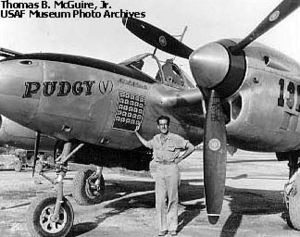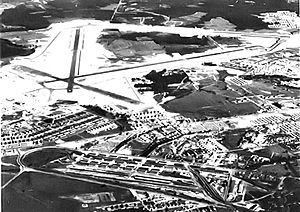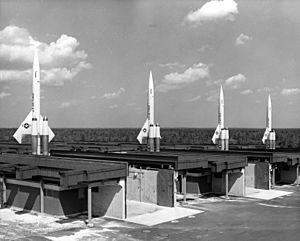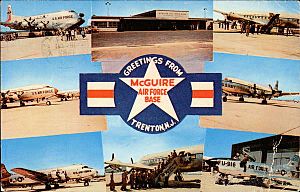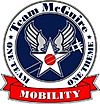McGuire Air Force Base facts for kids
Quick facts for kids McGuire AFB |
|||||||||
|---|---|---|---|---|---|---|---|---|---|
| Near Wrightstown, New Jersey in the United States | |||||||||

An aerial view of McGuire AFB in 1997
|
|||||||||
| Coordinates | 40°00′56″N 074°35′30″W / 40.01556°N 74.59167°W | ||||||||
| Type | US Air Force base | ||||||||
| Area | 40,000 acres (16,187 ha) | ||||||||
| Site information | |||||||||
| Owner | Department of Defense | ||||||||
| Operator | US Air Force | ||||||||
| Site history | |||||||||
| Built | 1937 (as Fort Dix Airport) | ||||||||
| In use | 1937 – 2009 | ||||||||
| Fate | Merged in 2009 to become an element of Joint Base McGuire–Dix–Lakehurst | ||||||||
| Airfield information | |||||||||
| Identifiers | IATA: WRI, ICAO: KWRI, FAA LID: WRI, WMO: 724096 | ||||||||
| Elevation | 42.9 metres (141 ft) AMSL | ||||||||
|
|||||||||
McGuire Air Force Base (AFB) is a key part of Joint Base McGuire-Dix-Lakehurst (JB MDL) in New Jersey. It's an important base for the United States Air Force, located about 16.1 miles (25.9 km) southeast of Trenton. McGuire AFB is managed by the Air Mobility Command, which handles air transportation for the military. In 2009, it joined with nearby Army and Navy facilities to form JB MDL.
The area where McGuire Air Force Base is located is also a special census-designated place (CDP). In 2020, about 4,522 people lived there.
Contents
What is McGuire AFB?
The main group at McGuire AFB is the 87th Air Base Wing (87 ABW). This wing helps manage all parts of JB MDL. They also train and prepare Airmen for military operations around the world. The 87 ABW includes over 3,100 people from the Air Force, Army, and Navy.
McGuire AFB started in 1941 as Fort Dix Army Air Force Base. It closed for a short time after World War II but reopened in 1948. The base was named after Major Thomas B. McGuire Jr., a brave pilot who received the Medal of Honor. He was the second-best American pilot (ace) in history.
On March 3, 1960, the famous singer Elvis Presley landed at McGuire Air Force Base. He was returning home from his time in the army in Germany, just two days before he was officially discharged.
Who Works at McGuire AFB?
Several important units are based at McGuire AFB, helping with air mobility missions. These units have supported many major operations over the past 15 years.
- 87th Air Base Wing
- 305th Air Mobility Wing
- 514th Air Mobility Wing (part of the Air Force Reserve)
- 108th Air Refueling Wing (part of the New Jersey Air National Guard)
- Marine Aircraft Group 49 (MAG-49) (part of the U.S. Marine Corps Reserve)
- Marine Helicopter Light Attack Squadron 773 (HMLA-773) (part of the U.S. Marine Corps Reserve)
- Fleet Logistics Support Squadron 64 (VR-64) (part of the U.S. Navy Reserve)
McGuire is special because it's the only base in the entire U.S. Air Force that has three different types of flying wings: from the regular Air Force, the Air Force Reserve, and the Air National Guard.
Other important groups at McGuire include:
- United States Air Force Expeditionary Center (USAF EC)
- 621st Contingency Response Wing (CRW)
- 373rd Training Squadron (373 TRS), Detachment 1
- AMC Test and Evaluation Squadron (TES)
McGuire's runways are very busy, helping Air Force planes and other contracted aircraft fly missions. Many thousands of military personnel have flown from McGuire AFB to places all over the world.
Airplanes from McGuire have also performed exciting flyovers for sports events. These include Philadelphia Eagles games, Major League Baseball All-Star games, and World Series games in Philadelphia. They also did the flyover for Super Bowl XLVIII.
A Look Back: History of McGuire AFB
How McGuire AFB Got Its Name
McGuire Air Force Base started as Fort Dix Airport in 1937. It officially opened for military planes on January 9, 1941. On January 13, 1948, the United States Air Force renamed it McGuire Air Force Base. This was to honor Major Thomas Buchanan McGuire Jr.. He was a hero from World War II who received the Medal of Honor. Major McGuire died on January 7, 1945, when his P-38 Lightning plane crashed during a dogfight in the Philippines.
McGuire During World War II
Even before the base was officially named, planes were flying here to support Camp Dix as early as 1926. In 1937, work began to build runways and facilities. This project was part of a big expansion for the Army Air Forces. The airfield was first called "Rudd Field."
To prepare for World War II, Rudd Field was renamed Fort Dix Army Air Base in 1939. It grew a lot between 1940 and 1941, with new concrete runways built.
In November 1941, the 59th Observation Group became the first permanent unit at the base. They flew various planes, like the O-47 and O-52 Owl, to patrol the East Coast for enemy submarines.
During World War II, Fort Dix Army Air Base became a training center. Many service units learned how to support flying missions. These units handled things like flight control, aircraft maintenance, security, and communications.
In 1943, the base also became a place where aircraft were repaired and prepared for overseas shipment. After the war ended in 1945, the base received planes returning from Europe. It also helped military groups that were coming home to be officially closed down.
Fort Dix Army Air Base was mostly shut down in late 1945 and became inactive in 1946.
McGuire and the United States Air Force
Strategic Air Command
McGuire Air Force Base was reactivated on August 29, 1948. It was first under the Strategic Air Command (SAC). The base was updated to handle new jet aircraft. Old wooden buildings from World War II were replaced with permanent structures.
The 91st Strategic Reconnaissance Wing was stationed at McGuire in November 1948. This unit used planes like the RB-17 and RB-29 to take photos and map areas from the sky. They moved to another base in 1949.
Air Defense Command
After the 91st SRW left, McGuire AFB was given to the Air Defense Command (ADC) in 1951. The ADC was in charge of protecting the skies.
Various fighter squadrons were stationed at McGuire during the 1950s. They flew interceptor planes like the F-94 Starfire, F-84 Thunderjet, and F-86D Sabre. Their job was to practice defending against enemy bombers.
In 1957, McGuire AFB became home to the first operational SAGE (Semi-Automatic Ground Environment) air defense system. This was a very advanced computer system for its time. It linked radar stations to a central center to give early warnings of air attacks. SAGE used the first computer with "magnetic cores" for memory and introduced many new computer ideas.
In 1959, the Air Defense Command placed CIM-10 Bomarc surface-to-air missiles at McGuire AFB. These were the first long-range anti-aircraft missiles used by the U.S. Air Force. The Bomarc missiles were supersonic and carried a nuclear warhead.
On June 7, 1960, there was an incident where a Bomarc missile with a nuclear warhead caught fire. The fire caused some contamination, but the area was cleaned up and covered with concrete. This site remains off-limits today because of low levels of contamination.
Strategic Airlift Missions
On July 1, 1954, the Military Air Transport Service (MATS) took over McGuire Air Force Base. Since then, McGuire's main job has been to transport military personnel and equipment all over the world. This mission continued under MATS's successor organizations, Military Airlift Command (MAC) and now Air Mobility Command (AMC).
The 1611th Air Transport Wing started flying C-118 Liftmaster planes worldwide. In 1962, they received C-135 Stratolifters, allowing them to carry heavier loads.
In 1966, MATS became the Military Airlift Command (MAC). The 438th Military Airlift Wing took over the mission at McGuire. They replaced the older propeller planes with the new C-141 Starlifter jets. For the next 30 years, the 438th MAW transported cargo, mail, and passengers globally, including during the Vietnam War.
McGuire was known as a major C-141 Starlifter base, holding a large part of MAC's fleet until the plane retired in 2004. In 1992, the base became part of the new Air Mobility Command.
McGuire in Modern Times
In 1994, the 305th Air Mobility Wing took over at McGuire. The C-141 planes were replaced by the C-17 Globemaster III in 2004.
McGuire AFB has been crucial in many recent global events.
- In 1999, it was a main base for helping Kosovo refugees in Operation OPEN ARMS.
- After the September 11, 2001 attacks, McGuire was a key point for FEMA operations in New York City.
- In 2005, the base provided important support during Hurricanes Katrina and Rita.
- In 2006, McGuire AFB hosted over 1,800 Lebanese Americans who were evacuated from conflicts.
- In 2008, McGuire took on the "Red Ball Express" mission, supplying efforts in Afghanistan (Operation ENDURING FREEDOM).
Today, the people at McGuire AFB continue to be at the forefront of military operations. They regularly send out airlift and refueling planes, as well as support teams, for combat missions.
McGuire AFB is now the lead service in the first tri-service Joint super-base. This means it combines its support with Fort Dix (Army) and Naval Air Engineering Station Lakehurst (Navy). New facilities and housing have been built, making McGuire one of the top Air Force bases.
Aircraft Flown at McGuire AFB
| Designation | Years |
|---|---|
| C-130 | 2011–present |
| C-9B | 2011–2012 |
| C-17 | 2004–present |
| KC-46 | 2021–present |
| KC-10 | 1994–2023 |
| C-141 | 1967–2004 |
| KC-135 | 1991–2023 |
| F-4E | 1985–1991 |
| F-4D | 1981–1985 |
| F-105B | 1964–1981 |
| F-94 | 1950–1952 |
| F-86 | 1953–1964 |
| F-84F | 1958–1962 |
| F-84E | 1955–1958 |
| F-82 | 1949–1951 |
| F-51H | 1952–1955 |
| P-47D | 1952 |
| F-106A | 1959–1967 |
| C-7 | 19??-19?? |
| C-121 | 19??-19?? |
| C-54 | 19??-19?? |
| C-118 | 19??-19?? |
| C-135 | 19??-1967 |
Environmental Efforts at McGuire AFB
In 2007, the United States Environmental Protection Agency asked the U.S. military to clean up certain areas at McGuire AFB. These areas included former waste disposal sites and places where fuels or other materials were handled. The base has worked to address these areas to protect the environment.
McGuire Air Force Base CDP: Community Information
|
McGuire AFB CDP
|
|||||
|---|---|---|---|---|---|
|
|||||
| Country | |||||
| State | |||||
| County | Burlington | ||||
| Townships | New Hanover North Hanover |
||||
| Area | |||||
| • Total | 5.364 sq mi (13.89 km2) | ||||
| • Land | 5.359 sq mi (13.88 km2) | ||||
| • Water | 0.005 sq mi (0.01 km2) 0.10% | ||||
| Elevation | 112 ft (34 m) | ||||
| Population | |||||
| • Total | 4,522 | ||||
| • Density | 843.03/sq mi (325.49/km2) | ||||
| Time zone | UTC−05:00 (Eastern (EST)) | ||||
| • Summer (DST) | UTC−04:00 (Eastern (EDT)) | ||||
| ZIP Code |
08641
|
||||
| Area code(s) | 609, 732 | ||||
| FIPS code | 34-42390 | ||||
| GNIS feature ID | 2389460 | ||||
The McGuire Air Force Base CDP (census-designated place) covers about 5.364 square miles (13.89 km2) of land. In 2020, its population was 4,522 people.
Population Changes Over Time
| Historical population | |||
|---|---|---|---|
| Census | Pop. | %± | |
| 1970 | 10,933 | — | |
| 1980 | 7,853 | −28.2% | |
| 1990 | 7,580 | −3.5% | |
| 2000 | 6,478 | −14.5% | |
| 2010 | 3,710 | −42.7% | |
| 2020 | 4,522 | 21.9% | |
| Population sources: 1970–1980 1990–2010 2000 2010 2020 |
|||
Who Lives Here? (2020 Census)
| Race / Ethnicity | Pop 2010 | Pop 2020 | % 2010 | % 2020 |
|---|---|---|---|---|
| White alone (NH) | 2,299 | 2,433 | 61.97% | 53.80% |
| Black or African American alone (NH) | 562 | 573 | 15.15% | 12.67% |
| Native American or Alaska Native alone (NH) | 14 | 13 | 0.38% | 0.29% |
| Asian alone (NH) | 97 | 156 | 2.61% | 3.45% |
| Pacific Islander alone (NH) | 24 | 33 | 0.65% | 0.73% |
| Some Other Race alone (NH) | 6 | 47 | 0.16% | 1.04% |
| Mixed Race/Multi-Racial (NH) | 202 | 356 | 5.44% | 7.87% |
| Hispanic or Latino (any race) | 506 | 911 | 13.64% | 20.15% |
| Total | 3,710 | 4,522 | 100.00% | 100.00% |
More About the Population (2010 Census)
In 2010, there were 3,710 people living in the CDP. About 67% of households had children under 18. Most households (75.4%) were married couples.
The population was quite young, with 36.5% under 18 years old and 25.2% between 18 and 24. The average age was 22.2 years.
Education for Base Families
Families living at Joint Base MDL (McGuire AFB and Fort Dix) send their children to local public schools. The Department of Defense Education Activity (DoDEA) does not run schools directly on this base. Families can choose from a few school districts for their children:
- North Hanover Township School District (Pre-Kindergarten to 6th grade)
- Northern Burlington County Regional School District (7th to 12th grade)
- Pemberton Township School District (Kindergarten to 12th grade)
Two schools from the North Hanover district are located right on the base:
- Discovery Elementary School (PreK-K)
- Atlantis Elementary School (grades 1-2)
The Northern Burlington County Regional School District serves students from several nearby townships, including children of Air Force personnel at McGuire AFB. This district has:
- Northern Burlington County Regional Middle School (grades 7 and 8)
- Northern Burlington County Regional High School (grades 9-12)
Getting Around: Transportation
New Jersey Route 68 connects McGuire AFB to major roads like U.S. Route 206, the New Jersey Turnpike, U.S. Route 130, and Interstate 195.
New Jersey Transit provides bus service to and from Philadelphia on the 317 route, making it easier for people to travel.
See also
 In Spanish: Base de la Fuerza Aérea McGuire para niños
In Spanish: Base de la Fuerza Aérea McGuire para niños






